Cooking your favourite meal over the open flames of a crackling campfire is one of the greatest joys of camping. Little beats the satisfaction of successfully transferring your at-home cooking skills to the nuances of cooking in the wild outdoors. However, the key to a smooth transition is ensuring you have the right campfire cooking equipment for the job.
Learning how to cook over a campfire also requires time and patience. So if you’re planning on going straight into cooking a Dutch oven stew for 10 people who are relying on you for sustenance, then it’s worth practising your developing campfire cooking skills first.
In this article you’ll find information about different methods of campfire cooking as well as an array of campfire cooking equipment that you may want to consider trying out or exploring more.
I am by no means an expert at cooking over a campfire. But I do love it and try to do it as often as I can. Every time I try out a new recipe or cooking method – or even when I bust out an old tried and tested one – I’m constantly learning new things. And because of this, I find campfire cooking a really nice focus for a weekend of car camping, an evening at the beach, or indeed, a Saturday morning in the back garden!
- Campfire cooking setup
- Cookware for campfire cooking
- Campfire cooking tools and utensils
- Campfire cooking safety equipment
- My portable campfire cooking setup
Campfire cooking equipment setup
Most campgrounds in the US have fire pits with a grate or grill. They’re ready to use straight away and you don’t usually need any other means to cook meals over your fire, other than cookware.
However, this isn’t such a common amenity in campsites throughout the rest of the world. And you’re not guaranteed to find a pre-existing campfire cooking setup in all US campgrounds, either.
So, if you want to be a self-sufficient camp cook, you tend to camp wild, you just want to cook in your backyard, or if you don’t want to risk the lack of campfire facilities, you’ll need to create your own campfire cooking set up.
Here are a couple of options that I love:

Bitty Big Q
Campfire cooking grates / grill
Best for: car camping, backpacking and canoe camping (if it’s a fold up one), versatility.
Use to cook: one pot meals, grilled veggies and meat, fried breakfasts, pasta dishes… anything you would cook on your hob at home.
Our choice: Bitty Big Q for lightweight camping, Frontrunner Spare Tire Mount Braai/BBQ Grate for car camping
Using a campfire cooking grate or grill is one of the easiest ways to turn a regular campfire into a useful and versatile heat source for cooking on.
We love the Bitty BBQ because it is so portable and lightweight which makes it an excellent option for wilderness feasts. It’s also freestanding with legs that fix at three different heights; perfect for a spot of temperature control!
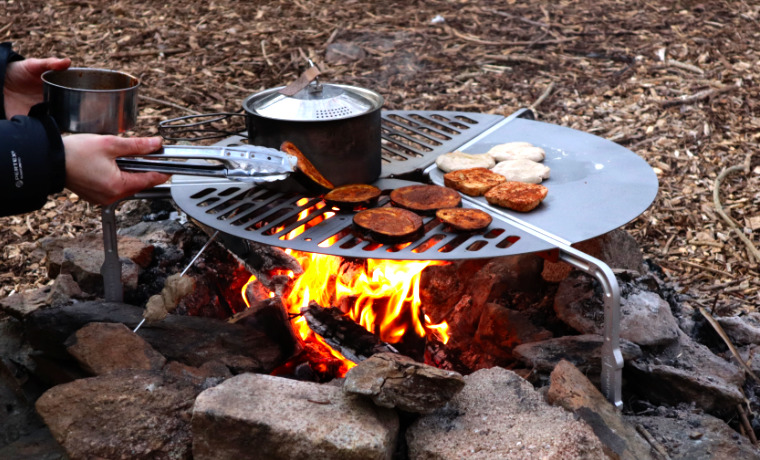
Frontrunner Grill
For car camping trips where we’re setting up for a few days or cooking for a group, we love cooking on the Frontrunner Spare Tire Mount Braai/BBQ Grate. It’s certainly not lightweight, but it has a huge coverage over the fire. The flat cooking section makes frying smaller or softer items doable without a pan which is a big bonus. And finally and rather uniquely, the grill fits over your spare car wheel taking up no room at all in the car!
Using a campfire cooking grate or grill allows you to cook as you would at home using your hob. Use stainless steel campfire cookware or a cast iron skillet (assuming you have a sturdy grill!) and you can boil, fry, simmer and stew. Additionally, a grate with small spaces between the bars enables you to grill food directly over the heat or wrapped in foil, making it a good option if you have limited campfire cookware.
DIY campfire grill alternative: use the grill from your BBQ at home and place it over a couple of rocks or large, slow burning logs.
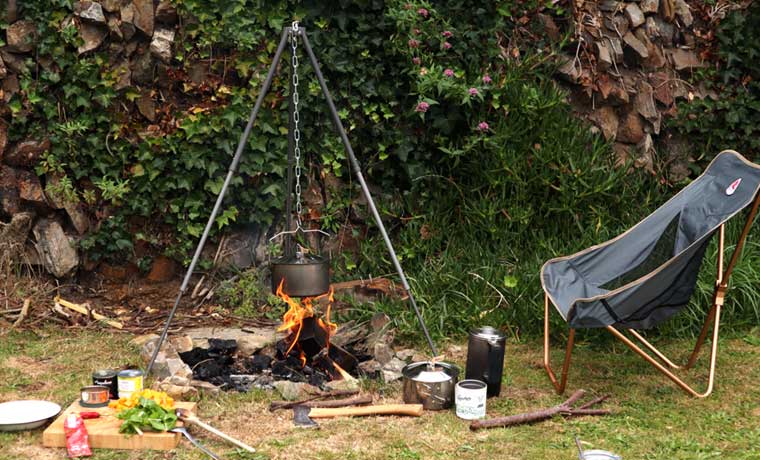
Campfire cooking tripod
Best for: car camping, backpacking and canoe camping (if it’s a fold up one), hanging out at camp.
Use to cook: stews, one pot meals, having hot water on the go all the time!
Our choice: Robens Telescopic Aluminum Tripod
Most campfire cooking tripods are fairly heavy duty and are best suited to car camping or setting up a base camp for an extended trip. However, the Robens Telescopic Tripod, which I’ve been using recently, is a super portable option. It weighs less than 1kg and folds up into an impressively small 53.5 x 6.5 cm package (with carry case and all!), making it a good campfire cooking equipment choice if you need to hike or paddle into your campsite.
Using a tripod to cook over a campfire is best used for cooking simple one pot meals that don’t require much attending to once all the ingredients are in the pot. It can also be a little tricky getting the height of the tripod right for optimal temperature control. But this is easily remedied by adjusting the hanging chain or the legs (if they’re telescoping).
Campfire cooking tripods are also an excellent addition to your campfire setup if you tend to spend lots of time just hanging out by the fire. Set up the tripod, hang a kettle of water on it and you’ve got yourself a constant supply of hot water for coffee or tea (or washing the dishes!).
There are hanging grills available that can be hung from campfire tripods. This adds a degree of versatility to the set up and enables you to grill food as well as using pots and pans that don’t have a bail handle.
DIY campfire tripod alternative: push two forked sticks into the ground either side of the fire and rest another stick on the forks to provide a cross bar to hang pots from.
Other campfire cooking stands (that I’ve not tried yet)
Rotisserie Grill and Spit
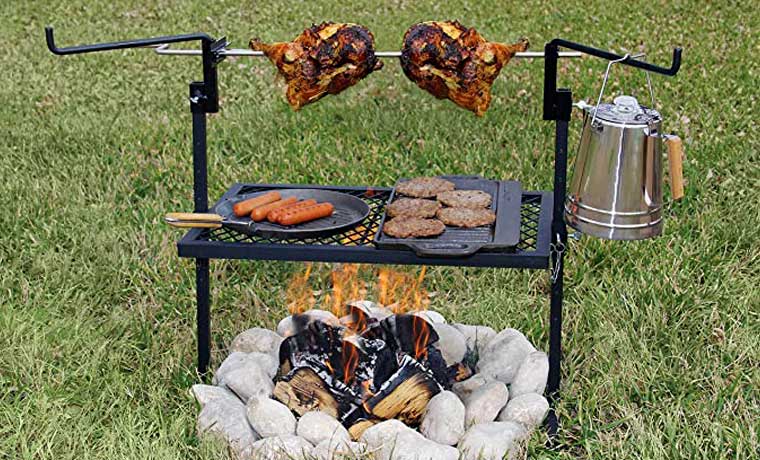 A rotisserie grill and spit should only be considered by the most committed (and patient) of meat lovers and serial Barbequers. However, if campfire cooking is your thing then this style of campfire cooking offers excellent versatility, enabling you to cook a huge array of meals, including a Sunday roast, should you wish! They usually pack flat for easy transportation.
A rotisserie grill and spit should only be considered by the most committed (and patient) of meat lovers and serial Barbequers. However, if campfire cooking is your thing then this style of campfire cooking offers excellent versatility, enabling you to cook a huge array of meals, including a Sunday roast, should you wish! They usually pack flat for easy transportation.Barbecue Swivel Grill
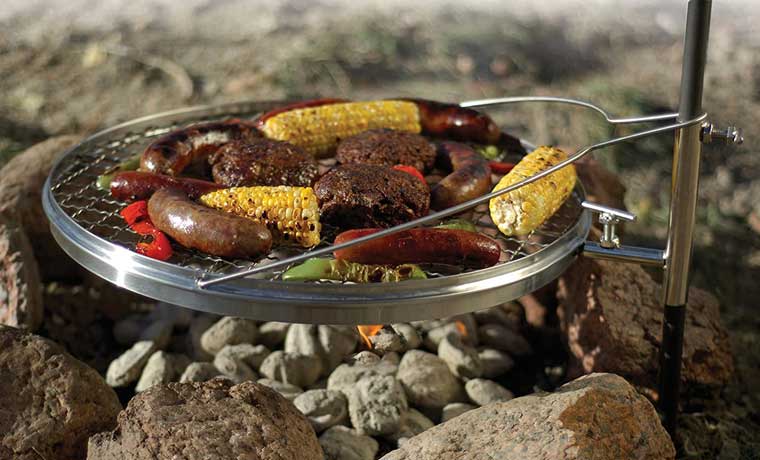 An alternative option to a regular grill is a barbecue swivel grill. These enable you to swing the grill off the heat when you need to serve up or tend to your food. Plus, the grill height can be easily altered to the size of your fire and fire pit. The nature of its design makes it best suited to grilling food directly over the flames rather than using cookware that may weigh too much for it to remain stable.
An alternative option to a regular grill is a barbecue swivel grill. These enable you to swing the grill off the heat when you need to serve up or tend to your food. Plus, the grill height can be easily altered to the size of your fire and fire pit. The nature of its design makes it best suited to grilling food directly over the flames rather than using cookware that may weigh too much for it to remain stable.
Cookware for campfire cooking
Once you’ve got your campfire cooking setup sorted, the next thing you need to think about is what type of cookware you want to use.
Your choice of cookware for campfire cooking depends on a few things:
- What sort of food do you like to cook? Do you mostly like grilled food? Are stews and casseroles your thing?
- How many people are you cooking for? There’s no use opting for a small single pie iron if you’re with a large group, for example.
- Is versatility important? Do you need to cook over gas as well as a campfire? Do you like to vary your cooking method?
- Is the weight of your cookware important? Stay clear of cast iron if you’re hiking!
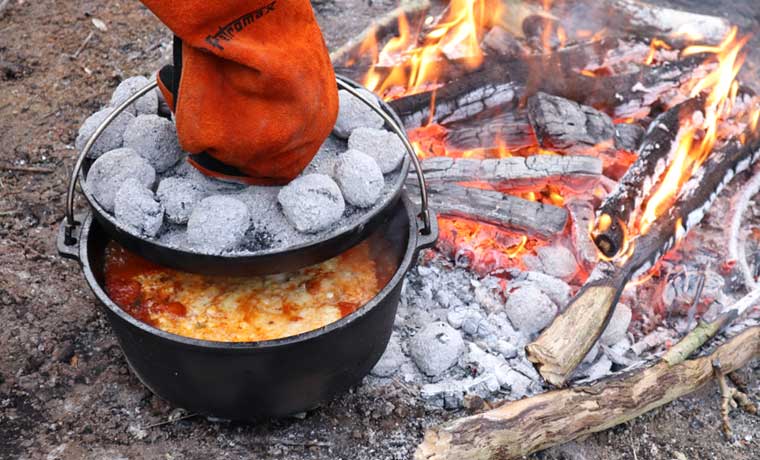
Dutch oven
Best for: group cooking, car camping, campers with lots of time on their hands, camping chefs.
Use to cook: stews, lasagna, bread, cakes, desserts, pizza… anything that you would cook in your oven at home.
Our choice: Robens Carsen Dutch Oven
Cooking with a Dutch oven is a bit of an art and takes some practise to get to grips with. But there’s also a lot of science behind it, which enables you to control the temperature inside the oven like you would a normal oven. This opens up a whole world of outdoor cooking that you might never have considered.
Dutch ovens can be placed directly onto the embers or a mature fire, suspended from a tripod or even placed on a grill. However, to get the best (and most consistent) results, briquettes should be used. Once hot, these provide consistent heat both below and above the oven that can be adjusted easily by adding or removing the coals. The number of coals you use also depends on the size of the oven.
There are a load of different size ovens available from 2 quart ovens that serve 2-4 people, to 12 quart ovens that serve 16-20 people. So, if group cooking is your thing, Dutch ovens are the bees knees!
For more information read our guide to camp cooking with a Dutch oven
NOTE: Certain recipes benefit greatly from being lined with foil or greaseproof paper to prevent food from getting burnt onto the inside of the oven.
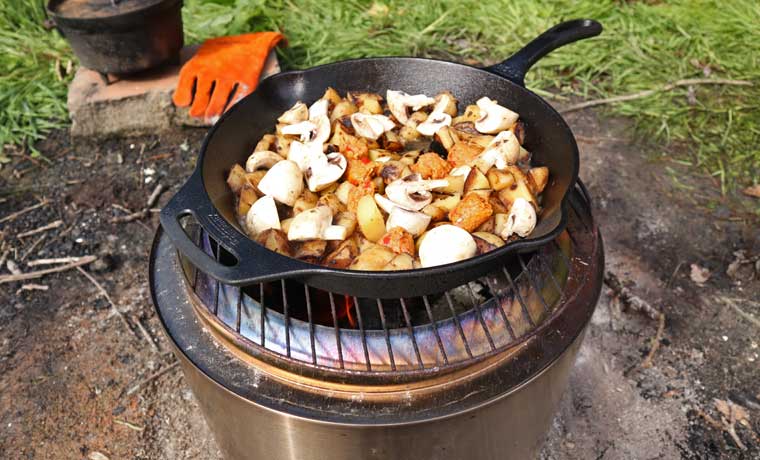
Cast iron skillet
Best for: car camping, quick cooking.
Use to cook: fried breakfasts, fried potatoes, paella, meat, veggies, and anything you’d usually saute or fry.
Our choice: Petromax Fire Skillet
The beauty of using cast iron cookware over a campfire is that it is incredibly durable. While stainless steel cookware is lightweight and decently robust, it will start to dent degrade over time, in comparison. Cast iron also retains heat for a long time.
We cook with the Petromax Fire Skillet directly over the fire or on top of a grate or grill. The sides protect the inside of the pan from flames creeping up and over, and it sits sturdily directly on burning coals or wood. As well as the small side handle for lifting with both hands, the Fire Skillet also features pouring spouts on the sides. This is useful for draining out excess oil after use, or for pouring sauces over the rest of your meal.
A skillet is a super versatile addition to your campfire cooking equipment setup. But, like Dutch ovens, you’ll need to treat it right to get the best out of it. Clean it with care: season it and condition it after use and store it properly when not in use.
NOTE: A lid is an excellent addition to a cast iron skillet. It enables you to use it a little more like a Dutch oven when cooking certain recipes by simply covering to keep the heat in, or covering and adding coals to the lid to cook from above.
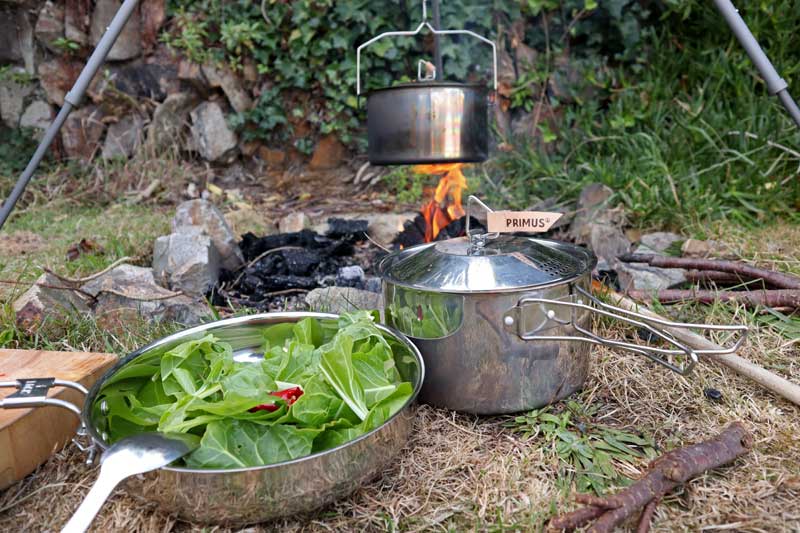
Campfire cookset
Best for: car camping, short backpacking trips, beach cooking, canoe camping.
Use to cook: most meals that you would normally cook on a hob.
Our choice: Primus Campfire Cookset
If you’d rather not learn a whole new method of cooking, then opt for a cookset that is designed to be used over a campfire. We love the Primus Campfire Cookset as it has the option to hang the large pan from a tripod as well as using the other pans either directly on the fire or placing them on a grill. The handles are all flame ready (no plastic or silicone) but you’ll need to use gloves or a cloth to lift them. Plus, there’s even little leather tabs on the lids that mean you can lift them without a heat proof pot holder.
This sort of cookset is a highly appealing piece of campfire cooking equipment for those who like to take their culinary adventures further afield. Cook freshly picked mussels at the beach, whip up a risotto on the riverside, or simmer a stew in the forest. Then fry up some garlic bread in your frying pan, boil a side of spuds in the small pan, and your wilderness feasts just got a whole lot more interesting!
NOTE: Campfire compatible cooksets are a good option if you also cook on a gas stove when camping – you only need one set for all your cooking needs.
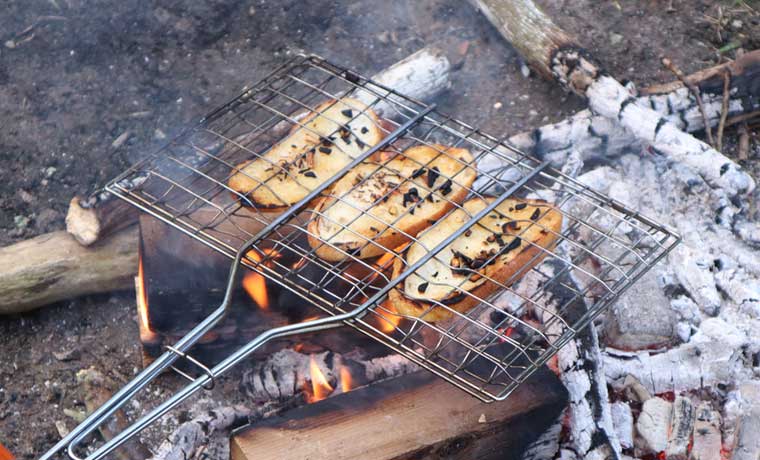
Grill basket
Best for: car camping, canoe camping, beach cooking, overnight hiking.
Use to cook: fish, toast, sausages, veggies, meat.
Our choice: Mr Barbeque Grill Basket
Though designed to be used over a barbeque, a grill basket is a surprisingly useful and versatile piece of campfire cooking equipment. Their flat-packed nature means that you might as well throw one in the car when car camping. Plus, they clip onto the outside of a backpack easily and are lightweight enough to carry on short overnight hiking trips for sizzling sausages at sunset!
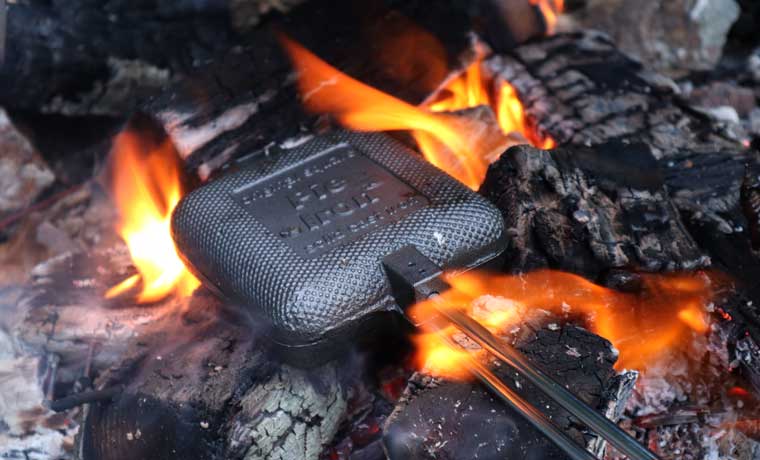
Pie Iron
Best for: car camping, toasted sandwich lovers, experimental chefs, kids.
Use to cook: toasted sandwiches, desserts, pancakes, pizza pockets, pies.
Our choice: Brick Wood and Iron Pie Iron
Pie irons are one of the more obscure bits of campfire cooking equipment that we use. And on the face of it, cooking with one is fairly limiting. You can’t boil rice or pasta in one, and they’re not really suitable for cooking a ‘proper’ meal. But, they do make THE best toasted sandwiches!
With some experimentation, you can actually cook quite an array of things in a pie iron. From pancakes, french toast and fruit-filled desserts, to pizza pockets, pastry pies and fried breakfast nests. Plus, pie iron recipes are super fun to make and cook with kids. They can add their favourite ingredients and even be in charge of their own pie iron once it’s in the fire.
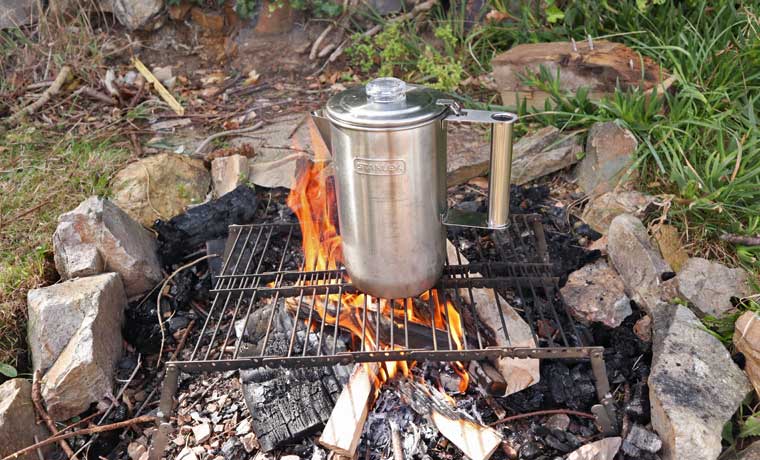
Kettle
Best for: car camping, groups, hanging out at camp, hot drink sippers, winter camping.
Use to make: coffee, tea, hot chocolate, and to serve cocktails and cold drinks.
Our choice: Stanley Adventure Cool Grip Percolator
A campfire compatible kettle is a must if you’re the kind of camper who likes having the fire going all day. Have hot water bubbling away on the flames for a constant supply of hot drinks to sip away at.
We love the Stanley Adventure Percolator. It has a removable silicone handle grip which means you don’t need to use a heat proof glove to pour. Plus, because the coffee basket is removable, it doubles as a kettle for tea or even a jug to serve up cold drinks and camping cocktails!
NOTE: If you’re not bothered about your kettle’s ability to make coffee, then opting for a kettle with a bail handle should be considered. This means you can hang it on a tripod over a fire should you wish.
Other campfire cookware (that I’ve not tried yet)
There are, of course, a whole host of campfire cooking equipment available that I’ve not tried yet. Most of them have rather specific uses and lack the versatility that the above-mentioned items do. However, they’re certainly worth mentioning, just in case campfire muffin making is just the thing you’re looking to try, for example!
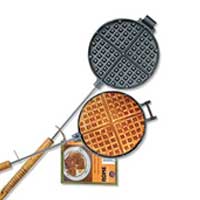
Waffle iron
Used in a similar way to a pie iron, waffle irons are excellent if you love your waffles! Fun to make and delicious to eat, but not really useful for much else.
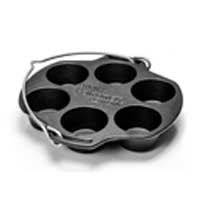
Muffin tin
Cast iron muffin tins can be used suspended over a fire, placed on coals or used in conjunction with a Dutch oven. They’re a great way to challenge your baking skills and the results are a delicious treat for your camping companions. You can also make mini frittatas and pastries in them for savoury snacking.
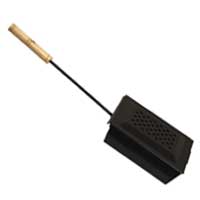
Popcorn popper
Like the waffle iron, popcorn poppers have fairly limited usefulness, especially when you can easily make popcorn in a regular pot over a campfire. However, if you have a lot of campfires which always feature popcorn, then you’re good to go with a popper!

Ring cake pan with tarte case lid
Campfire bakers can really step up their game with this beauty! Not only does it enable you to create a ring cake, the lid also doubles as a tarte case. Now that’s some fancy campfire cooking!
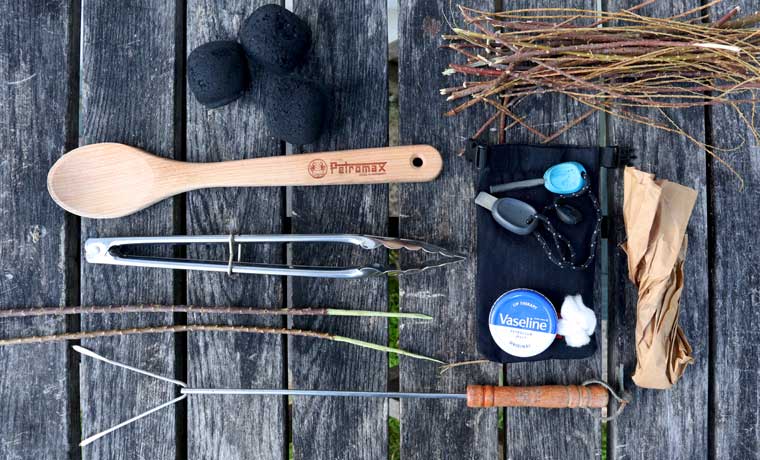
Campfire cooking tools and utensils
Cooking over a campfire is SO much easier when you have the right utensils for the job. The best campfire cooking tools are longer than your average cooking utensils to protect you from the heat. Some have wooden handles whilst others are metal and need to be used with heat proof gloves and pot holders.
The main campfire cooking tools you will need include:
Tongs
Not just great for moving food around your grill but also highly useful for moving briquettes and coals into position.
Wooden spoon
Though not as dexterous as a spatula for certain tasks (in which case, use your tongs), a wooden spoon is an essential when cooking with cast iron. It protects the surface from scraping and scratches that may occur with a metal utensil and you don’t have to worry about the handle getting hot!
Sticks and skewers
These are ideal for marshmallow toasting, sausage sizzling, bannock bread baking and chargrilling kabobs. Plus, using campfire sticks makes it very easy for the kids to get involved in dinner prep. We tend to make our own campfire sticks by whittling the ends off green twigs.
Fire starter kit
An essential part of cooking over a campfire is making the fire in the first place! Ensure you have a good fire starter kit and that you’re proficient at using it before you try your hand at cooking. Avoid artificial fire lighters as they are filled with chemicals and their fumes could end up getting into your food. Try making DIY fire starters instead.
Fuel
You’ll also need to ensure that you have a good supply of kindling to get your fire going, and sticks and logs to keep it going for as long as you want to be cooking for. Adding coals and briquettes to your campfire can be a very useful way of getting a more consistent heat. Briquettes are also ideal if you are cooking with a Dutch oven.
Campfire cooking safety equipment
Of course, spending lots of time around a campfire has its hazards, especially when you are concentrating on cooking instead of what the flames are doing! Always ensure that you have a bottle or bucket of water at the ready for burns or if the fire gets out of control. And it’s a good idea to have a first aid kit at hand, too.

Heat proof gloves
Heat proof pot holders are essential when dealing with metal handles. But better still are heat proof gloves. They enable you to be more dexterous when using utensils and holding pan handles than with a pot holder. I use Petromax Aramid Pro 300 gloves and love how safe I feel in them. They’re so robust that I can even pick up hot coals and move burning logs around in the fire (up to 482°F / 250°C). This is actually much more useful than you might realise as precise placement of logs and coals is key to the success of some types of campfire cooking. And it’s so much easier when you can just use your hands!
Gloves are also really versatile in terms of which campfire cooking equipment they are compatible with. Dutch oven lid lifters are great if you only ever cook with a Dutch oven. But you’ll also need gloves to move the oven around, not to mention when cooking with other types of cookware.
My portable campfire cooking setup
If I’m solely cooking over a campfire then my perfect combo of portable campfire cooking equipment is the Bitty Big Q and the Primus Campfire Cookset. Together they weigh only 5.3lbs / 2.42kg which is very doable for an overnight hike or for carrying to a remote spot to cook. However, depending on what the meal is, I don’t necessarily always take the whole of the cookset. One of the pots is sufficient to boil up some carbs if the rest of the meal is cooked on the grill. Likewise, the grill isn’t essential if the meal is totally pan-based. The pans can be placed between rocks or logs instead of the grill.
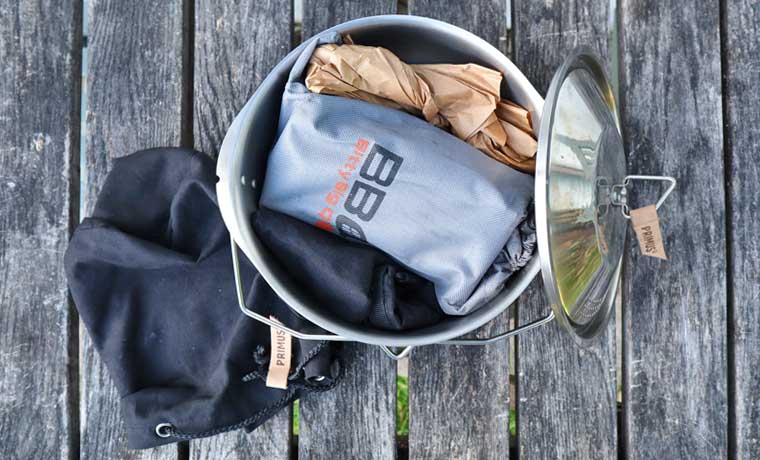
- If I take the large pot then the grill fits neatly inside it, together with my fire starter kit and some fire lighter. And because both the pots and the grill have their own carry case, the rest of the stuff in my backpack doesn’t get covered in soot when I come to pack it all away.
Wherever or however you choose to cook up a storm over a campfire, may your meals be hearty, your methods improve and your camping companions be well satisfied with the amazing food you serve up.
Happy cooking, happy campers!



